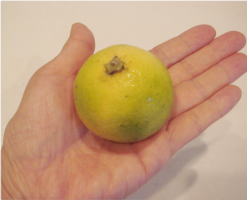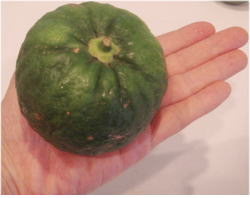Autumn Citrus ― 2009/10/05

We have plenty of choice of refreshing citrus fruits from the beginning of autumn to the end of winter. Particularly, during September and October, their colours, a gradation from lemon yellow to deep green, are also a feast to the eyes.
I don’t particularly like eating citrus fruits, such as oranges, grapefruits, and Satsuma, on their own, but when it comes to garnishing, I just love the tangy scent and taste of fresh citrus. I will squeeze a wedge of them over almost every plate.
Anytime I go to a green grocer, I will find different variety. Driven by a curiosity about how their scent and taste are different, I can’t resist buying them. Now my fridge is filled with a year’s supply of garnish. After a four years whimsical research, I came to have some opinions about them.
Kabosu
 The cheapest citrus fruit you will ever find; a pack of 10 or more costs about ¥198 (around US$1.08, as of 2009/10/05).
The cheapest citrus fruit you will ever find; a pack of 10 or more costs about ¥198 (around US$1.08, as of 2009/10/05).
The fruit is also the smallest citrus fruits available on market.
The juice tastes a bit bitter, and less sour.
The scent is very refreshing and pleasant.
Yuzu
 Lots of pips.
Lots of pips.
The fruit is relatively big. in this group
The juice tastes less sour, and not so sharp.
The zest has distinctive scent, so is used as a condiment, either fresh or dried.
Used in various way; eg. as a bath additive, as a tableware after being cut out the flesh, and as a new year’s ornament.
Locally Produced Lemon (even though it is green in this picture, it is not a lime)
 Compared to imported lemons mainly from the USA:
Compared to imported lemons mainly from the USA:
Difficult to find, and sometimes more expensive;
The skin is much thicker;
The taste is less tangy; and
You can use the zest at ease because in many cases they haven’t gone through chemical treatments against post-harvest decay (so I believe) .
I don’t particularly like eating citrus fruits, such as oranges, grapefruits, and Satsuma, on their own, but when it comes to garnishing, I just love the tangy scent and taste of fresh citrus. I will squeeze a wedge of them over almost every plate.
Anytime I go to a green grocer, I will find different variety. Driven by a curiosity about how their scent and taste are different, I can’t resist buying them. Now my fridge is filled with a year’s supply of garnish. After a four years whimsical research, I came to have some opinions about them.
Kabosu

The fruit is also the smallest citrus fruits available on market.
The juice tastes a bit bitter, and less sour.
The scent is very refreshing and pleasant.
Yuzu

The fruit is relatively big. in this group
The juice tastes less sour, and not so sharp.
The zest has distinctive scent, so is used as a condiment, either fresh or dried.
Used in various way; eg. as a bath additive, as a tableware after being cut out the flesh, and as a new year’s ornament.
Locally Produced Lemon (even though it is green in this picture, it is not a lime)

Difficult to find, and sometimes more expensive;
The skin is much thicker;
The taste is less tangy; and
You can use the zest at ease because in many cases they haven’t gone through chemical treatments against post-harvest decay (so I believe) .
最近のコメント